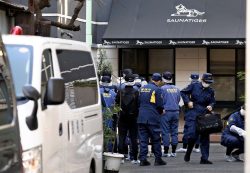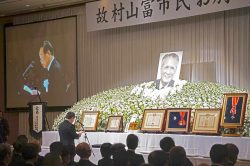10 Years since Mt. Ontake Eruption: Raise Awareness of Potential Disasters Posed by Volcanoes
16:14 JST, September 29, 2024
Ten years have passed since the eruption of Mt. Ontake, which straddles the Nagano-Gifu prefectural border. A total of 63 people died or remain missing, making it the nation’s deadliest volcanic disaster in the postwar period. Measures must be strengthened by making use of lessons learned from the incident.
The eruption occurred on Sept. 27, 2014. It was a pleasant Saturday and the autumn leaves were at their colorful best. By midday, there were many climbers at or near the summit. Although the eruption itself was not relatively large in scale, the combination of multiple factors resulted in much loss of life.
Few people immediately perceived the eruption as a threat to their lives. Upon seeing the volcanic smoke, some even continued taking photographs. But the smoke quickly enveloped the area, causing visibility to be lost. That made it impossible to escape the shower of falling volcanic rocks.
Those able to take shelter in mountain huts or behind rock formations managed to avoid direct hits from the volcanic rocks. Emergency shelters have been now set up near the summit. It is hoped that climbers pay heed to information on volcanic conditions before setting out, and equip themselves with helmets, towels to cover their mouths and other emergency items.
Even with precautions, predicting eruptions is difficult at the current level of science, making it unavoidable to be caught off guard. Prior to Mt. Ontake’s eruption a decade ago, there had been an increasing number of earthquakes recorded, but the Japan Meteorological Agency had left its volcanic alert at the lowest level of 1.
Amid concerns over dwindling research on volcanoes, in April, the government launched the Headquarters for Volcano Research Promotion to serve as a national command center. It is vital that funding be systematically secured, the efforts of researchers be consolidated and the system of volcanic research and observation be rebuilt.
Volcanoes across the Japanese archipelago have their own unique eruption patterns and topographical features. That makes it ineffective to discuss one-size-fits-all disaster measures. It is necessary to train researchers and government personnel in the local area to monitor specific volcanoes over many years and build up expertise.
In Nagano Prefecture, people with expertise on volcanic disaster preparedness can earn certification as a “Mt. Ontake volcano meister.” Based at visitor centers, they educate the public on disaster response and conduct awareness-raising activities. Such down-to-earth efforts can serve as a useful example for all areas of the country that have volcanoes.
While volcanoes at times show the terrifying power of nature, they also attract sightseers with their scenic beauty in normal times, and have long been a subject of faith. They also provide many benefits, such as hot springs, to areas at the foot of the mountains.
Japan’s first volcanic observatory was built on Mt. Asama during the Meiji era (1868-1912). The day of its establishment, Aug. 26, was designated as “Volcano Disaster Awareness Day” starting this year. The Nagano prefectural government has further designated the period from Aug. 26 to Sept. 27 as a month for volcano disaster awareness in the prefecture.
It is hoped that this will be a time to remember past disasters and think about how we can exist together with volcanoes.
(From The Yomiuri Shimbun, Sept. 29, 2024)
"Editorial & Columns" POPULAR ARTICLE
-

Violations of Subcontract Law: Major Automakers Must Eliminate Old Practices
-

Local Governments’ Tax Revenues: Devise Ways to Correct Imbalances in Tax Sources
-

5 Japanese Business Dinner Mistakes to Avoid — and What They Taught Me About Business in Japan
-

Heavy Rains in Asia: Support for Victims, Flood-Control Measures Urgently Needed
-

Rice Coupons: A Misguided Approach to Countering Rising Prices
JN ACCESS RANKING
-

Keidanren Chairman Yoshinobu Tsutsui Visits Kashiwazaki-Kariwa Nuclear Power Plant; Inspects New Emergency Safety System
-

Imports of Rare Earths from China Facing Delays, May Be Caused by Deterioration of Japan-China Relations
-

University of Tokyo Professor Discusses Japanese Economic Security in Interview Ahead of Forum
-

Tokyo Economic Security Forum to Hold Inaugural Meeting Amid Tense Global Environment
-

Japan Pulls out of Vietnam Nuclear Project, Complicating Hanoi’s Power Plans





















